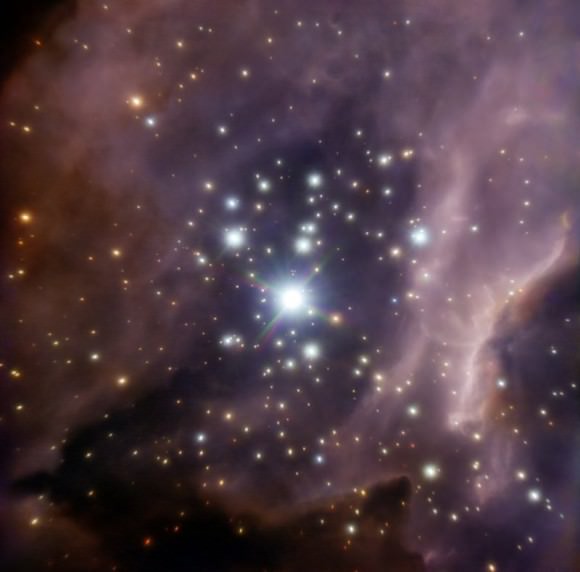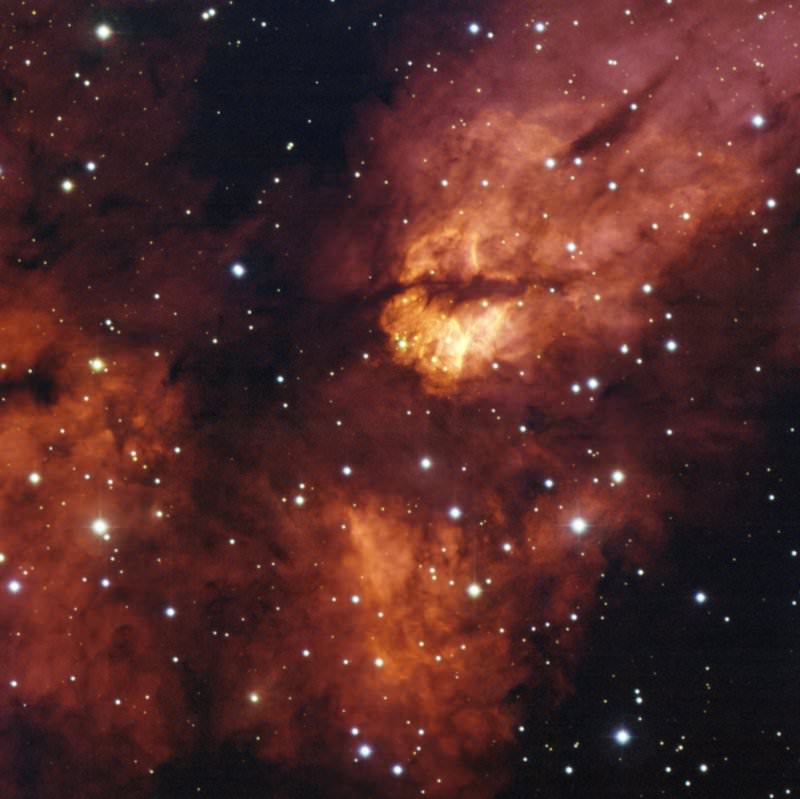[/caption]
We humans like to coddle and cuddle our young, protecting them in comfy, quiet nurseries where they will come to no harm. But what kind of treatment do infant planetary systems receive? They get bombarded with powerful winds and blazing heat, and pummeled by short-lived, massive stars that explode as supernovae. New images released today delve into the heart of a cosmic cloud, called RCW 38, crowded with budding stars and planetary systems. Although this is a hostile place, it makes a pretty picture, and new solar systems are in the process of forming in the same kind of environment from which our home may have evolved.
“By looking at star clusters like RCW 38, we can learn a great deal about the origins of our Solar System and others, as well as those stars and planets that have yet to come”, says Kim DeRose, first author of a new study that appears in the Astronomical Journal.
Star cluster RCW 38 is located about 5500 light years away in the direction of the constellation Vela (the Sails). Like the Orion Nebula Cluster, RCW 38 is an “embedded cluster,” in that the nascent cloud of dust and gas still envelops its stars. Astronomers have determined that most stars, including the low mass, reddish ones that outnumber all others in the Universe, originate in these matter-rich locations. Accordingly, embedded clusters provide scientists with a living laboratory in which to explore the mechanisms of star and planetary formation.

Using the NACO adaptive optics instrument on ESO’s Very Large Telescope astronomers have obtained the sharpest image yet of RCW 38. They focused on a small area in the center of the cluster that surrounds the massive star IRS2, which glows in the searing, white-blue range, the hottest surface color and temperatures possible for stars. These observations reveal that IRS2 is actually not one, but two stars — a binary system consisting of twin scorching stars, separated by about 500 times the Earth–Sun distance.
In the NACO image, the astronomers found a handful of protostars — the faintly luminous precursors to fully realized stars — and dozens of other candidate stars that have eked out an existence here despite the powerful ultraviolet light radiated by IRS2. Some of these gestating stars may, however, not get past the protostar stage. IRS2’s strong radiation energises and disperses the material that might otherwise collapse into new stars, or that has settled into so-called protoplanetary discs around developing stars. In the course of several million years, the surviving discs may give rise to the planets, moons and comets that make up planetary systems like our own.
Click here for video that zooms in on the RCW 38 massive cluster of stars. Starting with a wide angle view made with an amateur telescope, then to an image from Digitized Sky Survey 2, going to an image made with the MPG/ESO 2.2-metre telescope at La Silla and finishing with an image made with the NACO adaptive optics instrument attached to ESO’s Very Large Telescope.
As if intense ultraviolet rays were not enough, crowded stellar nurseries like RCW 38 also subject their brood to frequent supernovae when giant stars explode at the ends of their lives. These explosions scatter material throughout nearby space, including rare isotopes — exotic forms of chemical elements that are created in these dying stars. This ejected material ends up in the next generation of stars that form nearby. Because these isotopes have been detected in our Sun, scientists have concluded that the Sun formed in a cluster like RCW 38, rather than in a more rural portion of the Milky Way.
“Overall, the details of astronomical objects that adaptive optics reveals are critical in understanding how new stars and planets form in complex, chaotic regions like RCW 38”, says co-author Dieter Nürnberger.


Billy Idol’s “Rock the Cradle of Love” is going through my head now.
There’s a typo in the third line, second paragraph:
That “s” should be an “a” or “the”.
At the third paragraph, in the second line:
That statement is ambiguous; there should be a comma ( , ) between “Cluster” and “RCW 38”.
Err… I’ll get my coat and see myself out…
What would we do without your fastidious proofreading, IVAN3MAN? Did you remember your hat as well?
One day I’m going to write an article intentionally filled with typos, faulty parallelism, and misplaced commas just to see if I can blow IVAN3MAN’s mind.
Nancy Atkinson Says:
August 19th, 2009 at 7:49 pm
🙂
Nancy, these are awsome pics, out of this world energy!!!.
IVAN3MAN is very knowledgeable and intelligent and he has interesting, informative posts, I wish he just writes his opinions of the articles instead of ‘proofreading, because Nancy, if you indeed fill the article with typos,etc, IVAN3MAN will max the thread out with his corrections lol.
😀
Nancy, that was great!
And also the article, of course!
I wonder what happens to protostars that don’t quite become stars. Do they just settle down and become brown dwarfs?
@ Nexus,
Basically, affirmative.